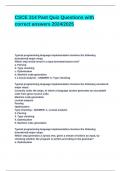Exam (elaborations)
CSCE 314 Past Quiz Questions with correct answers 2024_2025
Typical programming language implementation involves the following (unordered) major steps.
Which step would result in a type-annotated parse tree?
a. Parsing
b. Type checking
c. Optimization
d. Machine code generation
e. Lexical analysis
b. Type checking
Typical programming language ...
[Show more]
-
September 10, 2024
-
8
-
2024/2025
-
Exam (elaborations)
-
Questions & answers
-
CSCE
-
CSCE
CSCE 314 Past Quiz Questions with
correct answers 2024/2025
Typical programming language implementation involves the following
(unordered) major steps.
Which step would result in a type-annotated parse tree?
a. Parsing
b. Type checking
c. Optimization
d. Machine code generation
e. Lexical analysis - ANSWER- b. Type checking
Typical programming language implementation involves the following unordered
major steps.
Correctly order the steps, in which a language system generates an executable
code from given source code.
Machine code generation
Lexical analysis
Parsing
Optimization
Type checking - ANSWER- 1. Lexical analysis
2. Parsing
3. Type checking
4. Optimization
5. Machine code generation
Typical programming language implementation involves the following
(unordered) major steps.
Which step generates a syntax tree, given a stream of tokens as input, by
checking whether the program is written according to the grammar?
a. Optimization
, b. Lexical analysis
c. Parsing
d. Type checking
e. Machine code generation - ANSWER- c. Parsing
Consider the following Haskell definition of the list Monad.
instance Monad [] where
-- (>>=) :: [a] -> (a -> [b]) -> [b]
xs >>= f = [y | x <- xs, y <- f x ]
Suppose that you are showing the step-by-step of the following expression
explaining how the >>= operator works:
[1,2] >>= \x -> [x..3] >>= \y -> return (y+1)
Which one of the following values is not a value of y while evaluating the above
expression?If every value is a value of y, then choose "All values are values of y."
1
2
3
4
All values are values of y - ANSWER- 4
Given the following declaration of Haskell class Functor.
class Functor f wherefmap :: (a -> b) -> f a -> f b
What can go in the underlined space below so that the Functor laws are
preserved?
instance Functor Maybe where
fmap _ Nothing = Nothing
fmap f (Just x) = __________
a. Just (f x)
b. f (Just x)
c. Just f x
d. f x
e. Just f
f. Just x - ANSWER- a. Just (f x)
Typical programming language implementation involves the following
(unordered) major steps.
Which step would generate a token table from a stream of characters?




